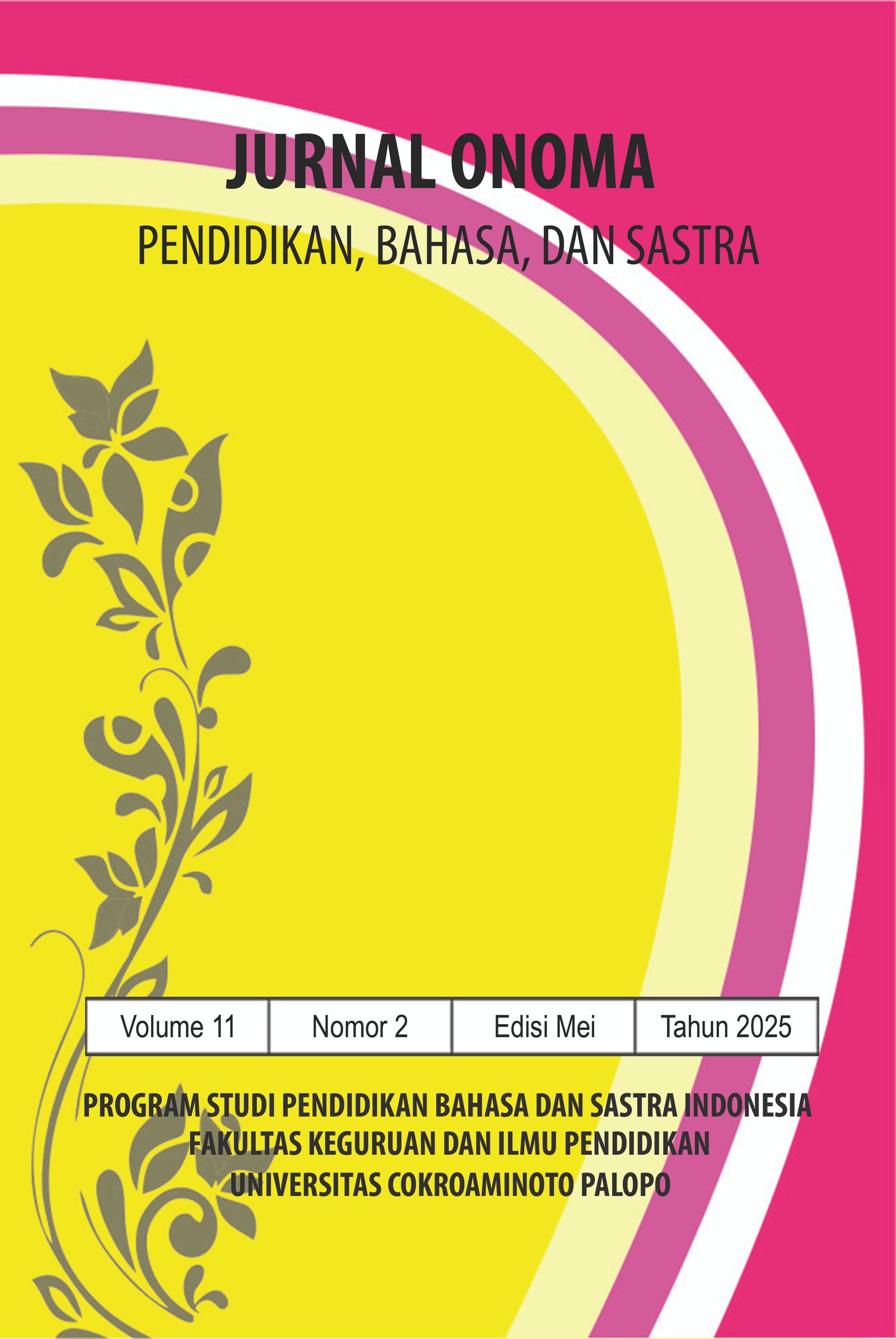Interpretasi Imajif dan Emosif melalui Metafora dalam Antologi Puisi Melipat Jarak Karya Sapardi Djoko Damono dan Relevansinya terhadap Pembelajaran Sastra di SMP
https://doi.org/10.30605/onoma.v11i2.5508
Keywords:
puisi, metafora, imaji, emosiAbstract
Penelitian ini bertujuan untuk mendeskripsikan penggunaan metafora dalam membangun imaji dan emosi dalam antologi puisi “Melipat Jarak” karya Sapardi Djoko Damono dan relevansinya terhadap pembelajaran sastra di SMP. Melalui pendekatan kualitatif, penelitian ini mengamati dan menganalisis penggunaan nmetafora dalam membangun imaji dan emosi yang terkandung dalam antologi puisi “Melipat Jarak” sesuai dengan teori linguistik kognitif Lakoff. Data penelitian berupa puisi-puisi “Melipat Jarak” karya Sapardi Djoko Damono. Sumber data dalam penelitian ini yaitu buku antologi puisi karya Sapardi Djoko Damono yang berjudul “Melipat Jarak” yang berjumlah 75 judul puisi. Data dianalisis dengan menggunakan teknik dokumentasi, teknik baca, dan teknik catat. Hasil penelitian ditemukan metafora berupa metafora struktural, metafora orientasional, dan metafora ontologis yang sesuai dengan pengklasifikasian metafora menurut Lakoff. Imaji berupa imaji visual (penglihatan), imaji taktis (rabaan), imaji auditorik (pendengaran), imaji olfaktori (penciuman), imaji gustatori (pengecapan), dan imaji kinestetik (gerak). Emosi berupa emosi positif, emosi negatif dan emosi netral. Pembelajaran sastra di SMP, khususnya puisi memerlukan pendekatan yang tepat untuk membantu siswa memahami makna dan pesan yang terkandung dalam puisi. Interpretasi imajif dan emosif melalui metafora merupakan salah satu pendekatan yang relevan dengan pembelajaran sastra di SMP.
Downloads
References
Damono, S.D. (2015). Melipat Jarak. Gramedia Pustaka Utama.
Geeraerts, Dirk and Hubert Cuyckens. 2007. The Oxford handbook of cognitive linguistics. Oxford.
Hasanuddin, dkk. (2002). Ensiklopedi Sastra Indonesia. Bandung: Angkasa
Lakoff & Johnson. 1980. “Metaphor We Live By”. Chicago: The University of Chicago Press.
Saryono, A., & Anggraeni, D. M. M. (2013). Metodologi penelitian kualitatif dan kuantitatif dalam bidang bahasa. Yogyakarta: Nuha Medika.
Wellek, Rene dan Warren. 2014. Teori Kesusastraan (Terjemahan Melani Budianta). Jakarta: PT Gramedia Pustaka Utama
Wirawan, G. 2016. “Analisis Struktural Antologi Puisi Hujan Lolos di Sela Jari Karya Yudhiswara”. Jurnal Pendidikan Bahasa Dan Sastra Indonesia. Bahasa Indonesia:1(2), 39–44. DOI: https://doi.org/10.26737/jp-bsi.v1i2.89
Downloads
Published
How to Cite
License
In submitting the manuscript to the journal, the authors certify that:
- They are authorized by their co-authors to enter into these arrangements.
- The work described has not been formally published before, except in the form of an abstract or as part of a published lecture, review, thesis, or overlay journal.
- That it is not under consideration for publication elsewhere,
- That its publication has been approved by all the author(s) and by the responsible authorities – tacitly or explicitly – of the institutes where the work has been carried out.
- They secure the right to reproduce any material that has already been published or copyrighted elsewhere.
- They agree to the following license and copyright agreement.
License and Copyright Agreement
Authors who publish with Onoma Journal: Education, Languages??, and Literature agree to the following terms:
- Authors retain copyright and grant the journal right of first publication with the work simultaneously licensed under Creative Commons Attribution License (CC BY 4.0) that allows others to share the work with an acknowledgment of the work's authorship and initial publication in this journal.
- Authors are able to enter into separate, additional contractual arrangements for the non-exclusive distribution of the journal's published version of the work (e.g., post it to an institutional repository or publish it in a book), with an acknowledgment of its initial publication in this journal.
- Authors are permitted and encouraged to post their work online (e.g., in institutional repositories or on their website) prior to and during the submission process, as it can lead to productive exchanges, as well as earlier and greater citation of published work.

















